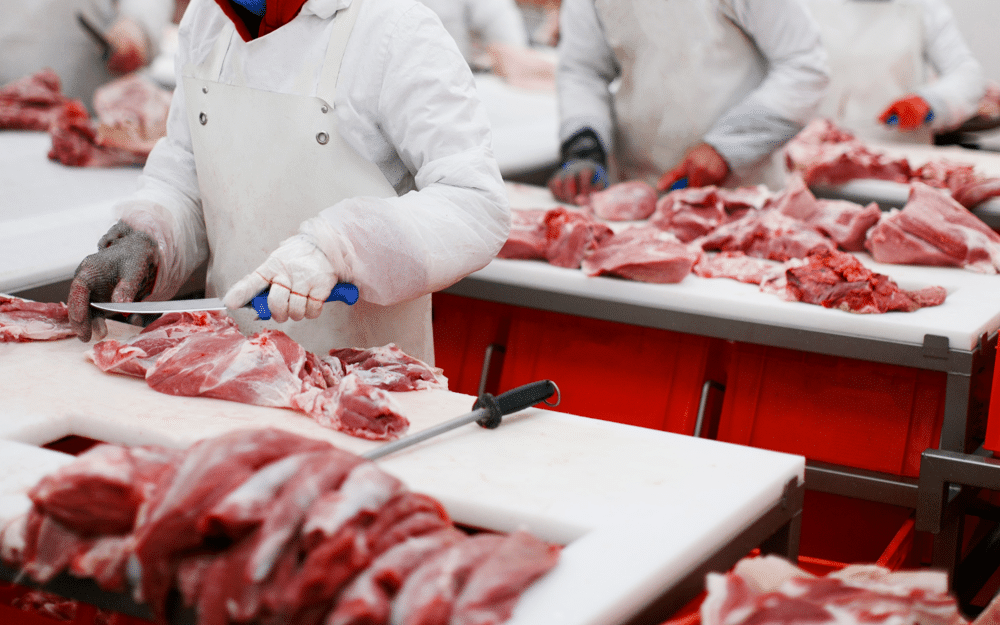Is Meat Consumption Increasing or Decreasing in Canada?

Understanding the trends in meat consumption is crucial for Canadian meat processors to make smart investment decisions. With changing consumer preferences and health guidelines, the country’s meat consumption landscape has been evolving over the years.
If you’re interested in meat consumption consumer trends in North America, don’t forget to check out our other article on Is Meat Consumption Increasing in the US?
How Much Red Meat is Consumed in Canada, and What Are the Trends?
Red meat consumption in Canada has been on the decline.
- Between 2004 and 2015, the average daily consumption of red meat (fresh and processed) in Canada decreased by 14 grams, from 75.4 grams to 61 grams. Fresh red meat consumption fell from 53.5 grams to 41.1 grams, while processed red meat slightly decreased from 21.9 grams to 19.9 grams.
- Looking further back, per capita beef consumption in Canada has steadily declined over the past few decades. In 1980, the average Canadian consumed 40.2 kilograms of beef and veal. By 2021, this number had dropped by 38.0% to 24.9 kilograms.
- The decline in beef consumption is linked to increased awareness of health concerns, such as obesity and heart disease.
Is Poultry the New Growth Frontier for Canadian Meat Processors?
Despite declining red meat consumption, poultry has emerged as a preferred choice among Canadians. Poultry, viewed as a healthier and lower-fat alternative, aligns with broader North American trends and offers significant growth potential for meat processing plants in Canada.
As consumers increasingly favor poultry, there is a prime opportunity for meat processors to innovate and expand their product lines to meet this rising demand.
- Poultry has become a preferred choice, viewed as a healthier and lower-fat alternative to red meat.
- Despite this shift, beef remains a staple in Canadian diets, although per capita consumption of beef and veal is projected to continue declining through 2025.
How can Meat Processors Address Nutritional Concerns?
While red meat consumption is decreasing, there is a crucial opportunity for processors to address potential nutritional gaps. Essential nutrients like iron, zinc, and vitamin B12 are primarily found in red meat. With a substantial portion of the population already consuming less than the recommended servings of meat, meat, and poultry processors have the chance to enhance their offerings to include fortified or enriched products that support overall health and well-being.
- A significant portion of the population, especially women and older adults, already consume less than the recommended servings of meat and alternatives.
- 48% of women aged 31-50 and 69% of women over 70 consume below the recommended levels.
- 56% of adolescent males also fall short of the recommended intake.
- Red meat is a primary source of essential nutrients like iron, zinc, and vitamin B12, which are crucial for mental health, energy levels, and healthy infant birth weight. Further reductions in red meat consumption could exacerbate deficiencies in these nutrients.
What Should Meat Processors Consider Regarding Consumer Trends?
For meat processors in Canada, understanding these trends is vital for strategic planning and investment decisions.
- The steady decline in red meat consumption, coupled with a shift toward poultry and other alternatives, highlights the need for processors to diversify their offerings and focus on consumer health trends.
- Staying informed about these patterns empowers processors to innovate and effectively meet the changing demands of the Canadian market.
Carlisle Technology has served the meat industry for over 35 years. With solutions in product weighing and labeling, traceability, and warehouse management, Carlisle Technology provides end-to-end solutions that help meat processors navigate the complex meat industry. Contact us today for more information on how we can help you!
Meat Consumption in the US vs. Canada:
How Does Canadian Chicken Consumption Compare to the U.S.?
United States:
Chicken remains the most consumed meat in the US, with consumption expected to rise from 98.90 pounds per person in 2022 to 107.50 pounds by 2033.
This growth is driven by chicken’s affordability, versatility, and health benefits, making it a staple in American diets.
Source: Check out Is Meat Consumption Increasing in the US?
Canada:
While specific data on chicken consumption wasn’t highlighted, the trend indicates a shift from red meat to poultry as a preferred source of protein due to similar health and cost considerations.
Poultry is viewed as a healthier and lower-fat alternative to red meat, aligning with the broader North American trend.
How Does Beef Canadian Consumption Compare to the U.S.?
United States:
Beef consumption in the US is expected to see a slight decline, from 59.10 pounds per person in 2022 to 56.90 pounds by 2033. This decrease reflects a growing preference for poultry and plant-based options, as well as concerns over health issues associated with red meat.
Source: Check out Is Meat Consumption Increasing in the US?
Canada:
Canada has seen a more significant long-term decline in beef consumption. From 1980 to 2021, per capita beef consumption dropped by 38.0%, from 40.2 kilograms to 24.9 kilograms.
This decline is also driven by health concerns such as obesity and heart disease, which have led many Canadians to reduce their red meat intake.
What Should Canadian Meat Processors Do Considering Consumer Trends?
Expand Product Lines: Embrace the growing demand for poultry by diversifying into chicken and other proteins.
Address Nutritional Gaps: Develop fortified products to replace nutrients lost from declining red meat consumption.
Highlight Health Benefits: Promote the health advantages of poultry to attract health-conscious consumers.
Monitor Trends: Stay updated on market shifts and adjust strategies to remain competitive.
By following these steps, processors can effectively adapt to evolving consumer preferences and drive growth.
Further readings on meat industry trends
Canada’s Meat Industry: Trends, Exports, and Economic Impact
How Big is the US Meat Industry
Sources:
Written by: Can Malay, Marketing Specialist – Carlisle Technology
Checkout more related resources!
Sign Up for Our Newsletter!
Receive updates on products, customer stories, and giveaways!
By submitting this form, you are consenting to receive marketing emails from: . You can revoke your consent to receive emails at any time by using the SafeUnsubscribe® link, found at the bottom of every email. Emails are serviced by Constant Contact



